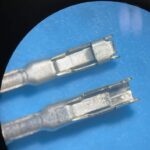Experiencing issues with your 1996 Toyota 4Runner can be frustrating, especially when trying to diagnose problems yourself. A crucial tool for modern vehicle diagnostics is the On-Board Diagnostics II (OBD2) port. This standardized port allows mechanics and DIY enthusiasts to access your vehicle’s computer system, read error codes, and gain insights into potential issues. If you’re having trouble connecting to your 96 4Runner’s OBD2 port, or simply want to understand more about it, this guide is for you.
Understanding the 96 4Runner OBD2 Port Location
First things first, locating the OBD2 port on your 1996 Toyota 4Runner is essential. For most vehicles of this era, including the 96 4Runner, the OBD2 port is typically found on the driver’s side of the dashboard, underneath the steering column. You might need to look under the dash area, and it’s often near the hood release lever or fuse box. The port is usually trapezoidal in shape and has 16 pins. Knowing the precise location ensures you can easily connect a diagnostic scanner when needed.
Why Your OBD2 Port Might Not Be Communicating
Sometimes, when you plug in an OBD2 scanner, you might encounter communication issues. This can be due to several reasons, and it’s not always a sign of a major problem. Here are a few common culprits:
- Scanner Compatibility: Ensure your OBD2 scanner is compatible with 1996 Toyota 4Runner models. While OBD2 is a standard, some older or very basic scanners might have limited compatibility.
- Ignition Position: For most OBD2 scanners to communicate, the vehicle’s ignition needs to be in the “ON” position (but engine not necessarily running). Simply having the key in the “ACC” position might not be enough.
- Blown Fuse: The OBD2 port is powered by a fuse in your vehicle’s fuse box. A blown fuse is a common reason for a non-functional OBD2 port. Consult your 4Runner’s owner’s manual to locate the fuse related to the diagnostic port or cigarette lighter, as they are sometimes on the same circuit, and check if it’s blown.
- Wiring Issues: Less commonly, there might be damage to the wiring leading to the OBD2 port. This could be due to corrosion, damage from rodents, or accidental disconnection.
- Vehicle’s Computer (ECM/ECU) Problems: In more serious cases, a failure within the vehicle’s Engine Control Module (ECM) or Engine Control Unit (ECU) could prevent OBD2 communication. If the ECM is malfunctioning, it might not be able to respond to the scanner’s requests.
Troubleshooting Steps for OBD2 Port Communication
If you’re facing OBD2 port communication issues with your 96 4Runner, here are some troubleshooting steps you can take:
- Verify Scanner and Ignition: Double-check that your OBD2 scanner is compatible with your vehicle year and make. Ensure the ignition is in the “ON” position.
- Check the Fuse: Locate the relevant fuse in your fuse box (refer to your owner’s manual) and inspect it. Replace it if it’s blown, and try the scanner again.
- Inspect the OBD2 Port: Visually inspect the OBD2 port for any signs of damage or bent pins.
- Try a Different Scanner: If possible, try using a different OBD2 scanner to rule out a problem with your scanner itself.
- Professional Diagnosis: If you’ve checked these basic steps and still can’t communicate with the OBD2 port, it’s best to consult a qualified mechanic. They can perform more in-depth diagnostics to pinpoint the exact cause, which could involve checking wiring continuity or assessing the ECM’s functionality.
Addressing Potential Underlying Vehicle Issues
While OBD2 port communication is crucial for diagnostics, it’s important to consider why you might be trying to use it in the first place. If you’re experiencing engine problems like rough idling, stalling, or poor performance in your 96 4Runner, and you’re also facing OBD2 communication issues, these problems might be related to the vehicle’s computer system.
In some scenarios, like the one described in the original forum post, intermittent engine problems accompanied by OBD2 communication failures can point towards potential ECM issues. However, this is a complex diagnosis that should be made by a professional mechanic after thorough testing. Issues like vacuum leaks, MAF sensor problems, or fuel delivery malfunctions can also cause similar symptoms and should be ruled out.
Conclusion
The OBD2 port is a vital access point for diagnosing issues in your 1996 Toyota 4Runner. Understanding its location and how to troubleshoot communication problems is a valuable skill for any car owner. By following these steps and seeking professional help when needed, you can effectively diagnose and address potential issues with your vehicle, ensuring its reliable performance for years to come. Remember to always prioritize safety and consult a qualified mechanic for complex repairs.
